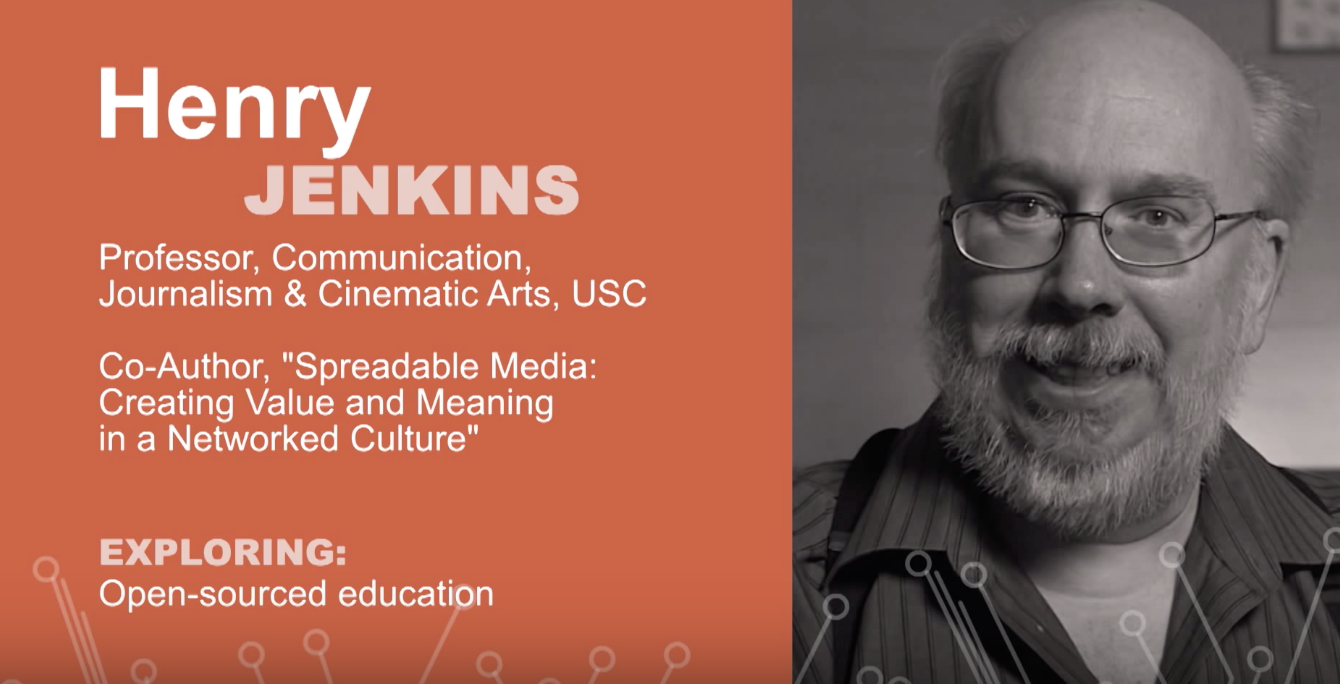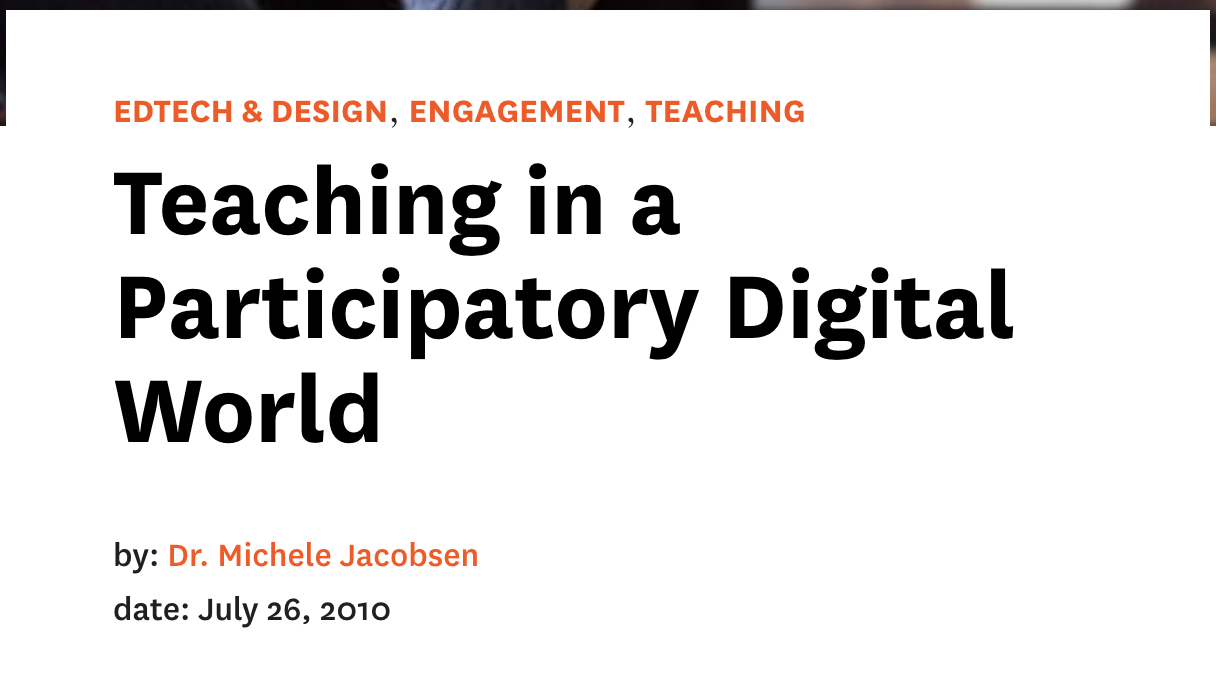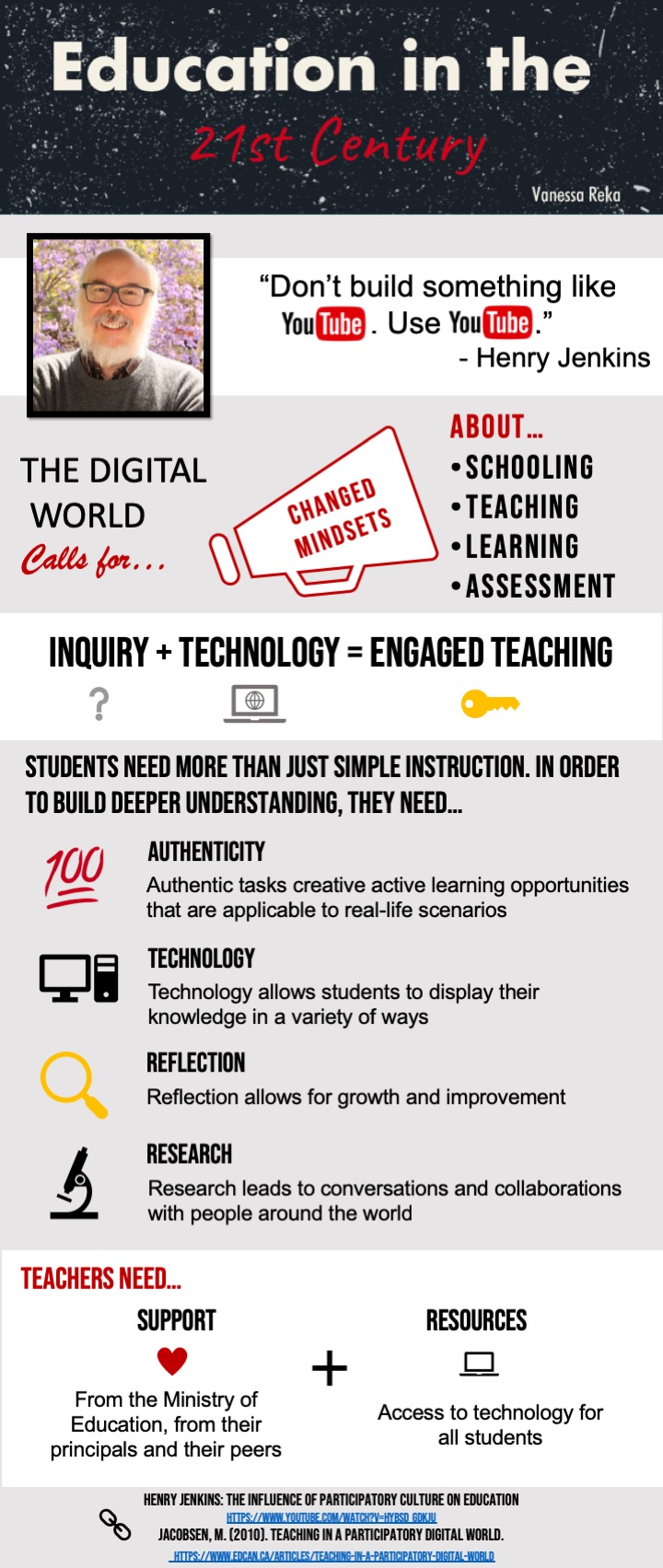For my second multimedia reflection I made my infographic based on Henry Jenkins’ Video: The influence of participatory culture on education, as well as the “Teaching in a Participatory Digital World” article written by Dr. Michele Jacobsen.


I chose to do an infographic using Piktochart and Microsoft PowerPoint. For the last reflection I made a sketchnote, so I decided to branch out from “pen and paper” to a fully digital medium. I enjoyed creating an infographic as I found it to be a clear and organized way to get points across. I am excited to try a different style of medium for my next reflection, as the infographic was easy to use but it was also slightly creatively restrictive. I used Piktochart to make my title banner, and then used PowerPoint to make the rest of my infographic. I chose to use both platforms as I find PowerPoint gives you more freedom, is more user-friendly and has less restrictions. I like the font selection on Piktochart, as well as the background options, which is why I used it to make the title banner.
When watching Jenkins’ video, I was struck by Jenkins’ saying “Don’t build something like YouTube. Use YouTube”, when referring to how a lot of educators are trying to remake things in technology that already exist. This really struck me as I think many people shy away from technology thinking that it is this dangerous thing that cannot possibly be used for educational purposes, when really, it can be an amazing and enriching tool. This also made me realize that “moving forward” onto bigger and better things is not always necessary, and instead there are benefits to working with what you already have.
Jacobsen’s article highlighted to me how it can be frightening for teachers to have to embrace so much new technology but also how rewarding it can be. I think many teachers are initially opposed to technology, because they simply don’t understand it. I remember in elementary school and high school, the majority of my teachers used an overhead projector, or simply just the chalkboard to teach our lessons. I even had one teacher who would use an actual old-school movie projector (I’m talking about the ones that use film), because they “couldn’t” find the movie in any other format…It was 2009. It’s not that the technology wasn’t out there and available in the late 90’s and early 2000’s, but instead it was new, and many educators were afraid to use it or were stuck in their ways. They were on their own when it came to technology, so my more tech-savvy teachers (often the younger ones), incorporated a little bit of technology into the classroom, but not nearly as much as is incorporated today. Jacobsen highlighted in her article, that top-down support is crucial for technology to be incorporated properly into classrooms. I think if more support and resources were provided to my teachers at that time, then they would have felt more comfortable with incorporating technology into the classroom.
Before reading this article, I never realized that the reason for lack of technology in my classrooms growing up, wasn’t necessarily because the teachers didn’t want to use it. Instead, it was because they didn’t have the necessary resources from administration to be confident in using it. Reading this article was very enlightening as it allowed me to think back on my past experiences with technology at school in a completely different manner. It made me critically think about how my school experience with technology could have been very different if my teachers were given the support mentioned in Jacobsen’s article.
The little use of technology from my school experiences is far from the participatory learning technologies that Jacobsen discusses in her article. Participatory learning is interactive, and it requires support from administration. Which is why I think it is so important that Jacobsen highlighted the need for top-down support. The ministry needs to provide professional development for principals so that they can better support their teachers and ensure that the students have the resources they need.
I plan on using the knowledge gained from Jacobsen’s article and Jenkins’ video in my own teaching practices, and hope to be able to incorporate technology in a meaningful manner. Jacobsen’s article reminded me of our lesson in Lecture #3 on the SAMR model (by Dr. R. R. Puentedura) about how technology should not be simply a substitution for something, but instead it should enhance and offer something more than what was possible before (redefinition). I am excited to further explore participatory learning, and use technology to redefine what was possible before. I am also excited to read and watch everyone else’s posts and opinions on the article and video.
Multimedia Reflection #2 – This link is to the .pdf version of my infographic, which has clearer images and working hyperlinks.
References:
Henry Jenkins: the influence of participatory culture on education. https://www.youtube.com/watch?v=HYbSD_GdkjU
Jacobsen, M. (2010). Teaching in a participatory digital world. https://www.edcan.ca/articles/teaching-in-a-participatory-digital-world
SAMR Model: A Practical Guide for EdTech Integration. https://www.schoology.com/blog/samr-model-practical-guide-edtech-integration
Image Sources:
https://annenberg.usc.edu/faculty/communication-journalism/henry-jenkins
https://cdn.shopify.com/s/files/1/1061/1924/files/100_Emoji.png?9898922749706957214

